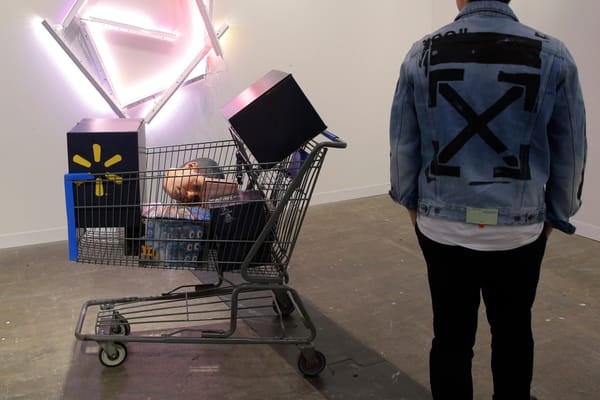When I first came across the artist Josh Kline’s work, it gripped me. Uncannily realistic human corpse sculptures sealed in body bags like Laura Palmer at the beginning of Twin Peaks were splayed out on the floor, alongside shopping carts and other detritus signifiers of modern waste. The show had a vibe,one that reminded me of Jonah Freeman’s and Justin Lowe’s installations of fictional interiors against theoretical apocalyptic wastelands and the neon-drenched debris pileup installations of the late Jason Rhoades. Moreover, Kline’s insistence on making art with radically new technological tools—3D printing, deep-fake software, and various digital technologies—showed an admirable openness to experimentation.
Yet Kline’s insistence on keeping up with the now has also been his greatest weakness—a weakness on full display in the current Whitney retrospective of his work. At times, his exhibitions feel like overwrought and overworked newsfeeds, delivering information in the exact same pessimistic and obnoxiously preachy tone as the media. He very much tells you—demands, even—that his art should be viewed as a political tool. For this reason, his work fails.
Kline’s politics are of the supposedly radical kind that ultimately end up being perfectly at home with the left liberalism that reigns supreme in our society. He is best understood as a representative of “left accelerationism”—a position that maintains a utopian hope for techno-liberation. He recently told Artforum editor David Velasco that he believes artificial intelligence could “liberate us from drudgery.” When have new technologies not benefited those who own assets to the detriment of those who don’t? Marx himself wrote about the machine, or “the automaton,” as the ultimate means of suppressing worker power. Even worse, at times, one could align Kline’s politics with a degrowth leftism that calls for a global decline in consumption. Do workers really want to live in a world where they have to consume even less?
The Whitney exhibition, titled Project for a New American Century, claims to address “work and class.” But the contradictions and limitations of Kline’s worldview become immediately apparent. While claiming to address labor and class, Kline simply assumes that various issues he cares about—climate change first and foremost, but also disease and the weakening of democracy—are matters of similar concern for the working class. Indeed, Kline’s politics and, by extension, his artistic practice are fundamentally bourgeois, strictly conforming to the liberal paradigm. Kline’s art can be technically interesting, but it is impossible to decouple the practice from the narrow-minded thinking behind it.
All the new work in the show—videos and installations alike—addresses climate change specifically. Remittances, for instance, is a new video that imagines climate refugees living in a tent. Writing for The New York Times, Jason Farago and Emma Goldberg say that for better or worse, Kline “has no time for subtlety.” I would say it’s for the absolute worst. There is a video titled Disinformation. There is advocacy for “universal basic income.” There is concern about the “fall of democracy.” Kline’s real talent seems to be less in making art than in cramming every liberal buzzword into a single retrospective.
In an interview in the show notes, Kline remarks that he finds it unfathomable that any artist could spend time painting pictures of flowers. Why? Why should an artist feel that he has to be anything other than an artist? Why should an artist have to do more than express what he finds to be beautiful, or meaningful, or evil, or compelling, or interesting, or dark? Kline begs critics to take him seriously by, weirdly, not taking his role as an artist seriously. Perhaps this sounds flippant, but if Kline thinks being an artist is so embarrassing, why does he insist on making art and receiving money from selling it? If he thinks that the world is indeed burning up, why isn’t he doing something that would actually address those problems?
Of course, some believe that Kline’s art is addressing those problems. According to the Times, Kline has shown an ability to anticipate crises—like the pandemic, “in his coronavirus-shaped plastic orbs that contain cardboard banker boxes, full of possessions you’d take home from the office after getting laid off.” But whether it is climate change or Covid, the crises Kline anticipates are every bit as manufactured as they are real. This makes him less a prophet of doom than a propagandist of doom-mongering.
